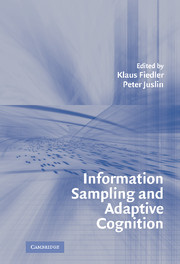Book contents
- Frontmatter
- Contents
- List of Contributors
- PART I INTRODUCTION
- PART II THE PSYCHOLOGICAL LAW OF LARGE NUMBERS
- PART III BIASED AND UNBIASED JUDGMENTS FROM BIASED SAMPLES
- 6 Subjective Validity Judgments as an Index of Sensitivity to Sampling Bias
- 7 An Analysis of Structural Availability Biases, and a Brief Study
- 8 Subjective Confidence and the Sampling of Knowledge
- 9 Contingency Learning and Biased Group Impressions
- 10 Mental Mechanisms: Speculations on Human Causal Learning and Reasoning
- PART IV WHAT INFORMATION CONTENTS ARE SAMPLED?
- PART V VICISSITUDES OF SAMPLING IN THE RESEARCHER'S MIND AND METHOD
- Index
- References
10 - Mental Mechanisms: Speculations on Human Causal Learning and Reasoning
Published online by Cambridge University Press: 02 February 2010
- Frontmatter
- Contents
- List of Contributors
- PART I INTRODUCTION
- PART II THE PSYCHOLOGICAL LAW OF LARGE NUMBERS
- PART III BIASED AND UNBIASED JUDGMENTS FROM BIASED SAMPLES
- 6 Subjective Validity Judgments as an Index of Sensitivity to Sampling Bias
- 7 An Analysis of Structural Availability Biases, and a Brief Study
- 8 Subjective Confidence and the Sampling of Knowledge
- 9 Contingency Learning and Biased Group Impressions
- 10 Mental Mechanisms: Speculations on Human Causal Learning and Reasoning
- PART IV WHAT INFORMATION CONTENTS ARE SAMPLED?
- PART V VICISSITUDES OF SAMPLING IN THE RESEARCHER'S MIND AND METHOD
- Index
- References
Summary
A fundamental goal of cognition is to reason about the causal properties of the physical and social worlds. However, as Hume (2004/1748) observed, knowledge of causality is puzzling because although events are directly observable, causal connections between them are not. Hume's puzzle has both philosophical and psychological aspects. The philosophical puzzle is how causal knowledge can be justified – that is, when should people infer causality? Hume argued that this problem is simply unsolvable – causality can never justifiably be inferred. But this leaves the psychological puzzle. Whether defensibly or not, people routinely do infer causality from experience; the puzzle is to understand what principles underlie these causal inferences.
Hume believed that this psychological problem was solvable: He suggested, in essence, that people infer causality from constant association or, in statistical terms, correlation. However, inferring causality from correlation is fraught with peril. One particularly serious difficulty concerns the theme of this book: sampling. Biased samples can induce numerous correlations that are spurious from a causal point of view; and, conversely, can lead to no correlation, or anticorrelation, where there is a causal link between events.
From Hume's skeptical perspective, this difficulty might not seem important. Indeed, if causal knowledge is unjustified and unjustifiable, there is really no question of whether causality is inferred correctly, or incorrectly: The associations between events are all there is. From a modern perspective, however, such skepticism seems untenable.
- Type
- Chapter
- Information
- Information Sampling and Adaptive Cognition , pp. 210 - 236Publisher: Cambridge University PressPrint publication year: 2005
References
- 3
- Cited by



